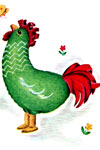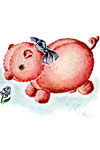Very interesting, hmmm...
You'll hear a lot from anti factory-farm people about how corn is bad & unnatural for animals. Humans have been feeding corn, and other grains, to farm animals for centuries. It is a good way to keep weight on the animals over winter.
The "problems" with corn are really more related to the factor-farm mentality and feed lots, where the animals are confined in a small area and fed corn to increase their weights right before slaughter. This adds a lot of the lovely fatty marbling that is so popular, but not a lot of nutrients.
Feeding entire stalks like this would be a good way to feed your animals for a few cold months, reducing feed costs (hay) for animals that don't need it (like the horses do) to be healthy. If you watch the video you'll noticed that there is a cow & llama in with these sheep.
Now, we do prefer the taste of grass-finished beef; it is a lot stronger tasting, more beefy, then what you get at the store; there is also some research that shows all that grass puts those good Omega3s into the beef. Something corn-fed cattle definitely don't have.
So, food for thought, either way.










